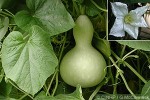Cook Islands Biodiversity Database
Species Page
Lagenaria siceraria
‘UeBottle Gourd
Multimedia & Additional Resources
| Type | Description | Download |
| Fruit, leaf and flower | 65KB | |
| The Bottle Gourd (Hue, ‘Ue) of ancient Polynesia Gerald McCormack, September 2005 |
Read |
General Information
Cook Islands Distribution
| Southern Group: Present Makatea: X | ||||||||
RR |
MG |
AT |
MK |
MT |
AK |
PL |
TK |
MN |
X |
+X |
X |
X |
X |
X |
- |
- |
- |
| Northern Group: - | |||||
TN |
MH |
RK |
PK |
NS |
SW |
- |
- |
- |
- |
- |
- |
Scientific Taxonomy
Lagenaria siceraria (Molina)
SYNONYMS: Cucurbita siceraria Molina 1782; Lagenaria vulgaris; Cucurbita lagenaria Linnaeus 1753; [Lagenaria vulgaris of TC was Benincasa]
TAXONOMY: PLANTAE; ANTHOPHYTA (=Angiospermae); MAGNOLIOPSIDA (=Dicotyledones); DILLENIIDAE; Violales; CUCURBITACEAE
More Information
SIGNIFICANCE NOTES -
BIODIVERSITY: Nationally extirpated. Comment: Original varieties extirpated. Varities re-introduced in early 1990s frm Hawaii also now rare or extirpated.
POSITIVE SIGNIFICANCE: Medicine, Material (Container). Comments: Fomerly used to make utensils, including water containers.
GENERAL NOTE: Gourd containers were very common in Hawaii and on Easter Island, especially as water bottles, less so in New Zealand, and distinctly secondary in Cooks and French Polynesia to large coconut and bamboo containers. In Hawaii they were used to make containers for many uses, along with rattles, drums and head-masks. In most of Polynesia gourd containers were often elaborately decorated.[Dodge 1978]
Vouchers & References
Vouchers:
Rarotonga: fieldspecimen, 1899, T.Cheeseman (1903) as "not often seen at the present time", with ID as Lagenaria vulgaris; not recorded by later botanists, except for a few plants grown from seed given by Hawaiians at the 1992 Arts Festival, and these plants were all gone within a few years, G.McCormack. Rarotonga: reported by A.Tuara of a few plants grown from seed given by Hawaiians at the 1992 Arts Festival, and these plants were gone within a few years, G.McCormack.
References:
p.813 Neal - In Gardens of Hawaii
p.633 Hortus 3rd
p.645 Royal Hort. Soc. Index of Garden Plants
p.382 Tropica
p.2/679 A.C.Smith - Flora Vitiensis Nova
p.281 A Cheeseman - Flora of Rarotonga
p.410d Whistler - Ethnobotany of the Cook Islands
Data Update History (information):
zTX, zB02, zM02, zupM03b, zD02
Web Resources
Citation Information
McCormack, Gerald (2007) Cook Islands Biodiversity Database, Version 2007.2. Cook Islands Natural Heritage Trust, Rarotonga. Online at http://cookislands.bishopmuseum.org. ![]()
Please refer to our use policy.

